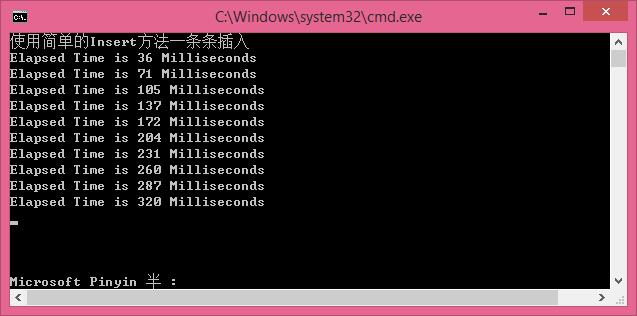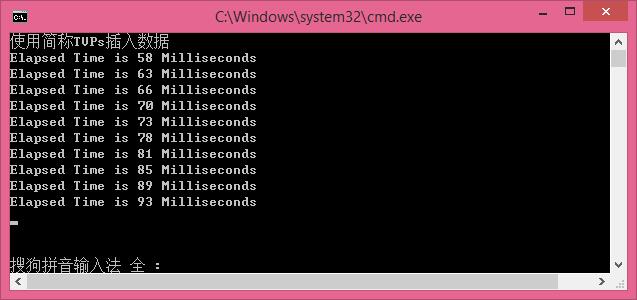SQL Server批量插入数据案例详解
在SQL Server 中插入一条数据使用Insert语句,但是如果想要批量插入一堆数据的话,循环使用Insert不仅效率低,而且会导致SQL一系统性能问题。下面介绍SQL Server支持的两种批量数据插入方法:Bulk和表值参数(Table-Valued Parameters),高效插入数据。
新建数据库:
--Create DataBase
create database BulkTestDB;
go
use BulkTestDB;
go
--Create Table
Create table BulkTestTable(
Id int primary key,
UserName nvarchar(32),
Pwd varchar(16))
go
一.传统的INSERT方式
先看下传统的INSERT方式:一条一条的插入(性能消耗越来越大,速度越来越慢)
//使用简单的Insert方法一条条插入 [慢]
#region [ simpleInsert ]
static void simpleInsert()
{
Console.WriteLine("使用简单的Insert方法一条条插入");
Stopwatch sw = new Stopwatch();
SqlConnection sqlconn = new SqlConnection("server=.;database=BulkTestDB;user=sa;password=123456;");
SqlCommand sqlcmd = new SqlCommand();
sqlcmd.CommandText = string.Format("insert into BulkTestTable(Id,UserName,Pwd)values(@p0,@p1,@p2)");
sqlcmd.Parameters.Add("@p0", SqlDbType.Int);
sqlcmd.Parameters.Add("@p1", SqlDbType.NVarChar);
sqlcmd.Parameters.Add("@p2", SqlDbType.NVarChar);
sqlcmd.CommandType = CommandType.Text;
sqlcmd.Connection = sqlconn;
sqlconn.Open();
try
{
//循环插入1000条数据,每次插入100条,插入10次。
for (int multiply = 0; multiply < 10; multiply++)
{
for (int count = multiply * 100; count < (multiply + 1) * 100; count++)
{
sqlcmd.Parameters["@p0"].Value = count;
sqlcmd.Parameters["@p1"].Value = string.Format("User-{0}", count * multiply);
sqlcmd.Parameters["@p2"].Value = string.Format("Pwd-{0}", count * multiply);
sw.Start();
sqlcmd.ExecuteNonQuery();
sw.Stop();
}
//每插入10万条数据后,显示此次插入所用时间
Console.WriteLine(string.Format("Elapsed Time is {0} Milliseconds", sw.ElapsedMilliseconds));
}
Console.ReadKey();
}
catch (Exception ex)
{
Console.WriteLine(ex.Message);
}
}
#endregion
循环插入1000条数据,每次插入100条,插入10次,效率是越来越慢。

使用使用Bulk插入[ 较快 ]
//使用Bulk插入的情况 [ 较快 ]
#region [ 使用Bulk插入的情况 ]
static void BulkToDB(DataTable dt)
{
Stopwatch sw = new Stopwatch();
SqlConnection sqlconn = new SqlConnection("server=.;database=BulkTestDB;user=sa;password=123456;");
SqlBulkCopy bulkCopy = new SqlBulkCopy(sqlconn);
bulkCopy.DestinationTableName = "BulkTestTable";
bulkCopy.BatchSize = dt.Rows.Count;
try
{
sqlconn.Open();
if (dt != null && dt.Rows.Count != 0)
{
bulkCopy.WriteToServer(dt);
}
}
catch (Exception ex)
{
Console.WriteLine(ex.Message);
}
finally
{
sqlconn.Close();
if (bulkCopy != null)
{
bulkCopy.Close();
}
}
}
static DataTable GetTableSchema()
{
DataTable dt = new DataTable();
dt.Columns.AddRange(new DataColumn[] {
new DataColumn("Id",typeof(int)),
new DataColumn("UserName",typeof(string)),
new DataColumn("Pwd",typeof(string))
});
return dt;
}
static void BulkInsert()
{
Console.WriteLine("使用简单的Bulk插入的情况");
Stopwatch sw = new Stopwatch();
for (int multiply = 0; multiply < 10; multiply++)
{
DataTable dt = GetTableSchema();
for (int count = multiply * 100; count < (multiply + 1) * 100; count++)
{
DataRow r = dt.NewRow();
r[0] = count;
r[1] = string.Format("User-{0}", count * multiply);
r[2] = string.Format("Pwd-{0}", count * multiply);
dt.Rows.Add(r);
}
sw.Start();
BulkToDB(dt);
sw.Stop();
Console.WriteLine(string.Format("Elapsed Time is {0} Milliseconds", sw.ElapsedMilliseconds));
}
}
#endregion
循环插入1000条数据,每次插入100条,插入10次,效率快了很多。

打开sqlserrver,执行以下脚本:
--Create Table Valued
CREATE TYPE BulkUdt AS TABLE
(Id int,
UserName nvarchar(32),
Pwd varchar(16))

成功后在数据库中发现多了BulkUdt的缓存表。
使用简称TVPs插入数据
//使用简称TVPs插入数据 [最快]
#region [ 使用简称TVPs插入数据 ]
static void TbaleValuedToDB(DataTable dt)
{
Stopwatch sw = new Stopwatch();
SqlConnection sqlconn = new SqlConnection("server=.;database=BulkTestDB;user=sa;password=123456;");
const string TSqlStatement =
"insert into BulkTestTable (Id,UserName,Pwd)" +
" SELECT nc.Id, nc.UserName,nc.Pwd" +
" FROM @NewBulkTestTvp AS nc";
SqlCommand cmd = new SqlCommand(TSqlStatement, sqlconn);
SqlParameter catParam = cmd.Parameters.AddWithValue("@NewBulkTestTvp", dt);
catParam.SqlDbType = SqlDbType.Structured;
catParam.TypeName = "dbo.BulkUdt";
try
{
sqlconn.Open();
if (dt != null && dt.Rows.Count != 0)
{
cmd.ExecuteNonQuery();
}
}
catch (Exception ex)
{
Console.WriteLine("error>" + ex.Message);
}
finally
{
sqlconn.Close();
}
}
static void TVPsInsert()
{
Console.WriteLine("使用简称TVPs插入数据");
Stopwatch sw = new Stopwatch();
for (int multiply = 0; multiply < 10; multiply++)
{
DataTable dt = GetTableSchema();
for (int count = multiply * 100; count < (multiply + 1) * 100; count++)
{
DataRow r = dt.NewRow();
r[0] = count;
r[1] = string.Format("User-{0}", count * multiply);
r[2] = string.Format("Pwd-{0}", count * multiply);
dt.Rows.Add(r);
}
sw.Start();
TbaleValuedToDB(dt);
sw.Stop();
Console.WriteLine(string.Format("Elapsed Time is {0} Milliseconds", sw.ElapsedMilliseconds));
}
Console.ReadLine();
}
#endregion

循环插入1000条数据,每次插入100条,插入10次,效率是越来越慢,后面测试,将每次插入的数据量增大,会更大的体现TPVS插入的效率。
到此这篇关于SQL Server批量插入数据案例详解的文章就介绍到这了,更多相关SQL Server批量插入数据内容请搜索软件开发网以前的文章或继续浏览下面的相关文章希望大家以后多多支持软件开发网!
相关文章
Psyche
2020-08-11
Vidonia
2020-10-17
Psyche
2023-07-20
Winola
2023-07-20
Gella
2023-07-20
Grizelda
2023-07-20
Janna
2023-07-20
Ophelia
2023-07-21
Crystal
2023-07-21
Laila
2023-07-21
Aine
2023-07-21
Bliss
2023-07-21
Lillian
2023-07-21
Tertia
2023-07-21
Olive
2023-07-21
Bonnie
2023-07-21
Angie
2023-07-21
Nora
2023-07-24